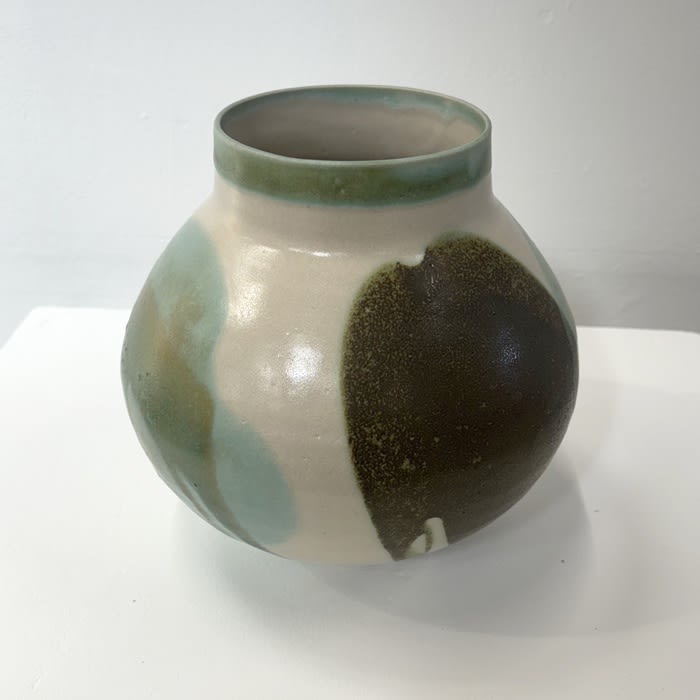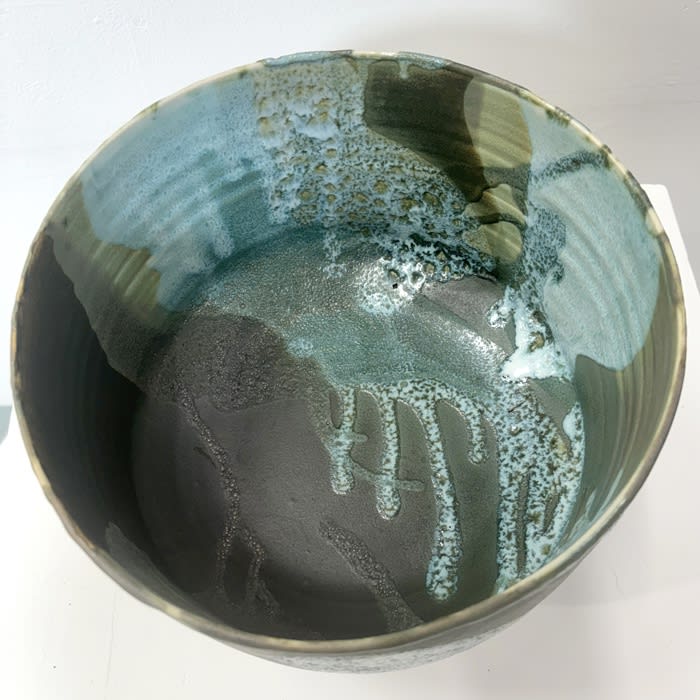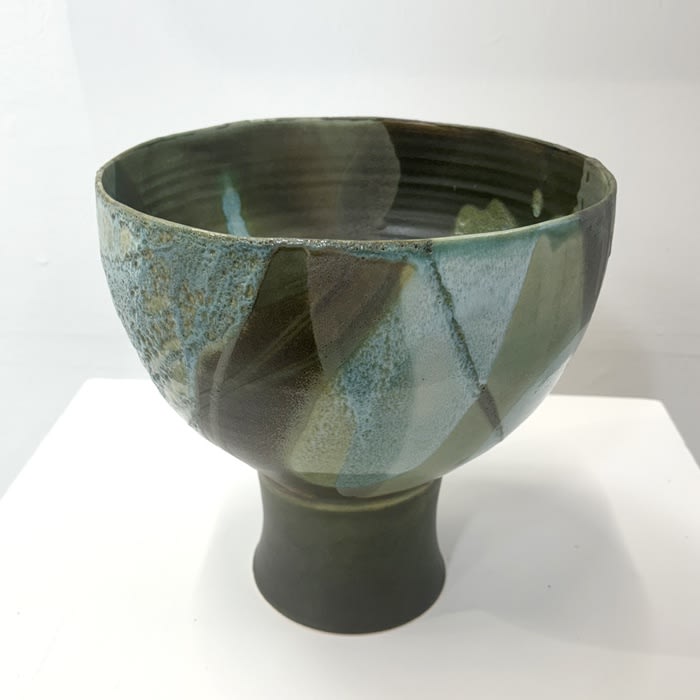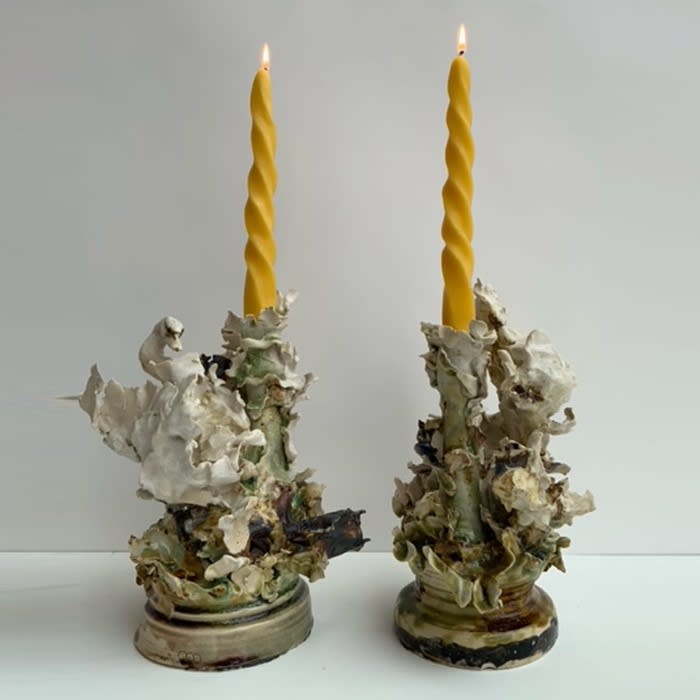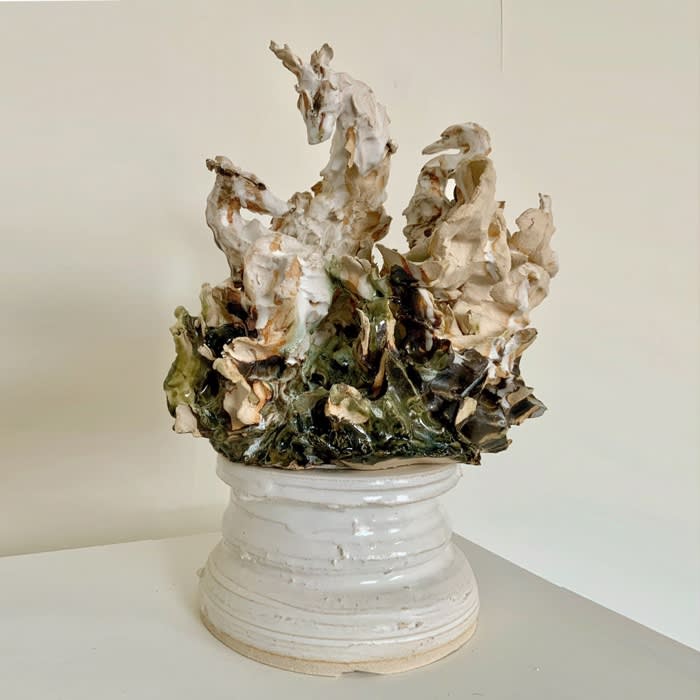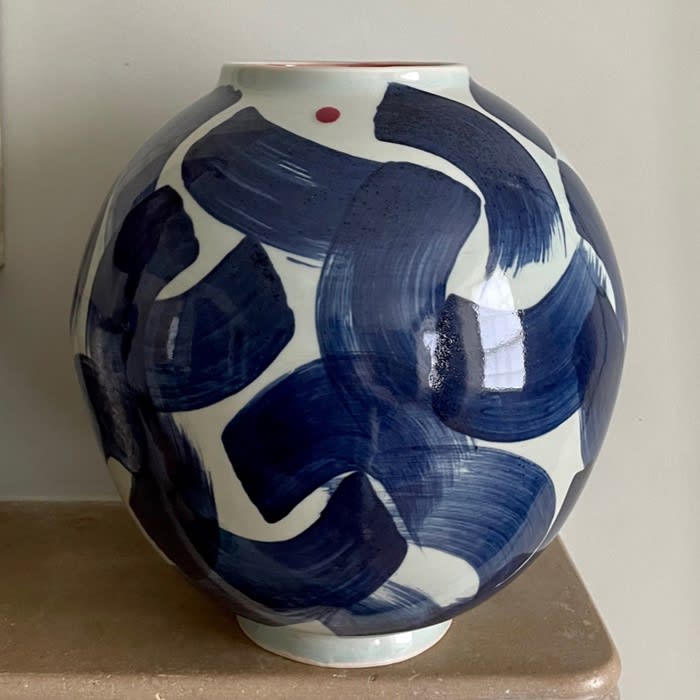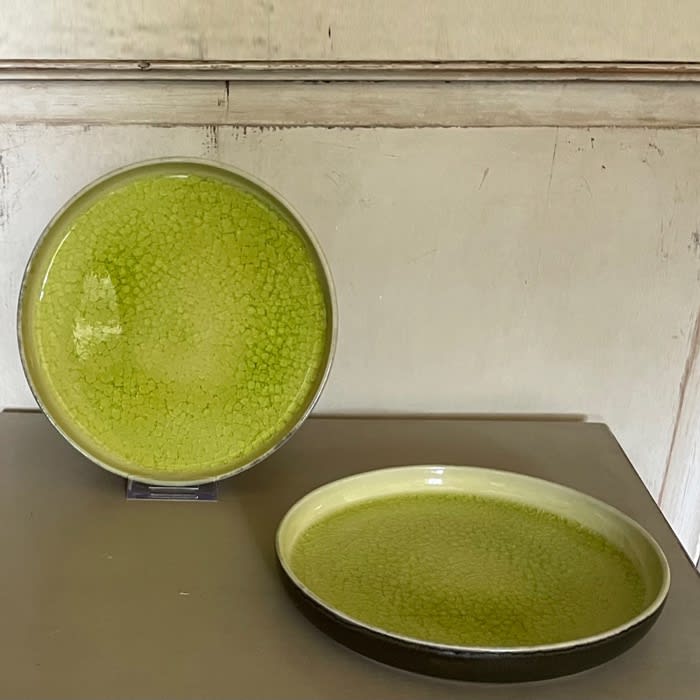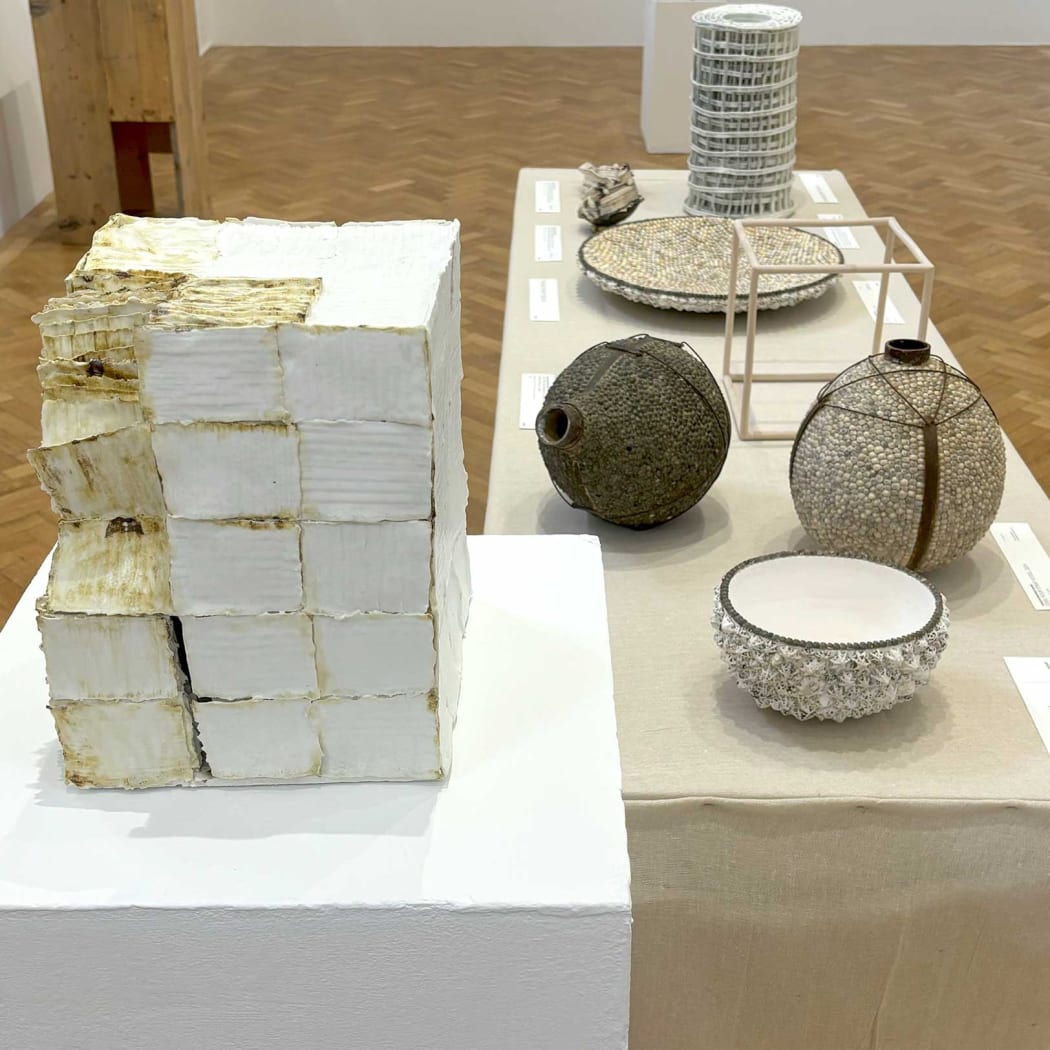
Installation in the Fermoy Gallery, on the plinth Hesston Long Gone 2024 by Kathryn Hearn, selection on the table by Carolyn Brookes-Davies, Caroline Chouler-Tisser, Kathryn Hearn and Jack Wheeler
Contemporary sculpture is probably at its most innovative in ceramic media at the moment. Shared properties of malleability and relative ease of supply are a timely reminder that "Nothing is new except what has been forgotten"*. Historically, sculptors used to sketch out their ideas in three dimensions using an inexpensive material like terracotta before they committed their ideas to stone, or bronze. Frequently the energy and immediacy of the terracotta version was considered superior to the finished sculpture.
Advances in firing techniques have meant that modern ceramics have transformed into something much more permanent, taking on the qualities of a material like bronze or stone, when fired at high temperatures.
The artists and makers have selected the materials they want to work with over some time, avoiding the restriction of previous convention - from porcelain, to stoneware or raw clay, they can create extraordinary forms using processes intrinsic to the outcome of their pieces.
In Lay of the Land the contributing artists and makers are also bearing witness to an emotional consideration of the East Anglian landscape, its variation and unique features. Some work figuratively, some are process led, with a more experimental or playful approach. Some employ highly prized decorative techniques to great effect, while others tend to be more thought-provoking in their intention through the marriage of form and function.
Established makers like Caroline Chouler-Tissier, Laura Huston, Kat Wheeler, and Cecilia Willis explore their own techniques. Each has a different approach. They have achieved acclaim over many years, navigating formal education and training to graduate or post graduate levels as well as their own teaching and making experience. There are several RCA graduates among them. Some have carved out successful commercial careers in selling their work into important collections within the UK as well as internationally. These include the V&A Museum, London, the Potteries Museum and Art Gallery, Stoke-on-Trent, Crafts Council Collection. Several also take part in national showcases such as 'Collect'- a yearly exposition in London.

Installation by Kathryn Hearn - two vessels - Bulging Bale and Cage and Moving Bale and Cage 2024, and a wall mounted sculpture by Jack Wheeler, Fetch 2024
Kathryn Hearn has developed her distinctive porcelain vessels by exploiting the intrinsic qualities of her materials, inspired by the Fenland landscape that surrounds her workshop in Cambridgeshire. The largely manmade landscape of the Fens are a constant source of inspiration for her. The patchwork of vast fields defined by man-made ditches and dikes have a way of highlighting the irregularities within the strange beauty of Fenland topology. Her forms reference factory farming on a grand scale, taking visual reference from the modern means of harvesting or storing crops from the fields in huge building-sized stacks of bales or cages. This is what Van Gogh or Monet would be recording instead of their picturesque haystacks if they were working in Cambridgeshire now.

Installation by Caroline Chouler-Tissier of two extruded wall-pieces 2022/2023 and two vessels 2022
Caroline Chouler-Tissier’s work is an exploration of materiality through a series of disruptive processes. Through the narrative at play in her work, she interrogates trauma and its impacts upon, both personal and the broader social context. She explores place, through the emotional energy of loss and solace of close contact with the rural landscape.
James Evans says of his ceramic sculpture: "For the past five years I've been developing new forms and surface treatments to my work, that break with tradition and follow the route of many of my peers trying to forge new paths of expression in ceramics. I don't know if it comes with age, but my work has become more reflective of the past. There is evidence of age with use of rusting iron and peeling metal leaf, and the forms fractured presence. When making the work I enjoy creating references that are incomplete and open to interpretation, allowing the observer to mull over it's past/present purpose".

James Evans Contorted Furrows 2021
Laura Huston's ceramic vessels are tactile, handmade pieces with gestural markings on the surface of the clay. Experimenting is key to Laura's pots and each success inspires a new body of work. She re-works ideas, playing with form, function, decoration, texture and glazes to create a surface that has a tactile depth.
Selection of vessels 2024 by Laura Huston
Laura is influenced by and admires the work of: John Ward, Lucie Rie, Ian Godfrey, and Korean Buncheong ware, admired for their timeless beauty, ancient quality of their work and the way the decoration is integral to the pots. Like those she is inspired by, her pots possess a utilitarian simplicity and balance, complimented by both the subtle mark-making and the vibrant gestural strokes that decorate their surfaces.
Selection of sculpture, candlesticks, paintings and drawings 2024 by Nessie Stonebridge
Nessie Stonebridge has also ventured into sculptural ceramics. More widely known for her action packed drawings and paintings, she has added these fluid ceramic forms to her output in the last few years, getting to know what the clay will do in her hands. The energy at the centre of Nessie’s sculpture is almost centrifugal in their arrangement (there is no front or back). Like her distinctive paintings and drawings, her ceramic forms describe the interplay between the wild creatures she observes, intimating their fight-or-flight behaviour. Beyond their Rococo folds and animal characters, these ceramic pieces are impressive for their self-containment. Each piece describes a world in miniature counterposing formal sculptural elements, alongside the utility of providing something as eternal as candlelight.

Installation by Kat Wheeler - three stoneware lidded jars with decoration
North Norfolk based potter Kat Wheeler takes her inspiration from the calmness and beauty of her surroundings on the coast, from the wide expanse of the beaches to the countryside that surrounds her studio. She works with a subdued, neutral palette and prefers the beauty of the clay and the traditional build process to take centre stage in her work. The decoration lies deeply incised within the clay walls of her pots. She creates small batches of hand-thrown, high-fired functional stoneware. Her pieces combine form and function with simple lines and mastery of the making process.
Installation by Cecilia Willis - a selection of moon jars, bowls and dishes
Twenty years living in Asia has given Cecilia Willis a profound appreciation of the Japanese aesthetic and this together with her decorator’s eye has influenced her creative work ever since.
Cecilia loves the generosity of the bowl form, seeking a simplicity and elegance of shape and striving to create glazes of luminous colour and depth for her pieces. Her bowls and dishes are intended as much for the decoration of a space as for the serving of food. Exploring the moon jar form, looking for the rightness of brush mark decoration and achieving a particular colour of glaze are all part of the excitement as the work evolves.
Lay of the Land has closed now. It was held at the The Fermoy Gallery and Shakespeare Barn, St George's Guildhall 29 King Street, King's Lynn PE03 1HA.
*Quote attributed to Marie Antoinette
About the author

Paul Barratt
Paul Barratt started working in contemporary art galleries in 1989, having graduated in Fine Art from Goldmsith’s, London University. He initially worked at Anthony d’Offay Gallery, one of the contemporary art dealers, who dominated the London art market in the 80s and 90s. He was approached by the Lisson Gallery to be gallery manager for the influential art dealer Nicholas Logsdail. This was followed by a short period in New York at Gladstone Gallery, to work for visionary art dealer Barbara Gladstone, working with the artist and filmmaker Matthew Barney.
On his return to London, Paul secured a place on the postgraduate curatorial course at the Royal College of Art, to complete an MA. After graduation in 2001, he worked as an independent curator on several projects in Oslo, London, Brighton and Basel, before joining Paul Vater at his design agency Sugarfree in 2004. He has worked with Paul ever since.





